Recently, many people prefer vinyl wallpaper to decorate the walls of their home. This is explained by the fact that the outer polyvinyl chloride layer can be given the texture and color of almost any wall finishing material. On the other hand, this polymer substance has important performance properties that determine the durability of the wall covering.
To ensure that your view of this wallpaper is objective and your choice meaningful, this article will discuss the following issues.
- What is polyvinyl chloride (PVC) wallpaper?
- What types of them exist?
- What are their advantages and disadvantages?
Although the type of wallpaper in question is usually called vinyl, in reality only its front side consists of PVC, which performs an aesthetic and protective function. Such wallpaper has two layers, one of which is the base, designed to firmly connect to the wall surface through a special adhesive composition. The base, or bottom layer, which different types of vinyl wallpapers have, can be either non-woven or paper. The other layer, the top one, is vinyl in its different interpretations, expressed in the fact that this material can differ not only in color and surface relief, but also in the composition and structure of the substance itself.
Types of vinyl coverings
At the moment, there are four main types of external coating vinyl wallpaper.
- Smooth vinyl cover, sometimes called kitchen or dense, made from rubberized polyvinyl chloride, which gives it greater density and water-repellent properties. The surface of wallpaper made of such material can be really smooth, but this is not the rule. Manufacturers often give the outer layer a relief design, imitating wall cladding made of natural and artificial materials, such as natural stone, ceramic tile, balsa wood and so on. Smooth vinyl is usually applied to a non-woven backing, so these wallpapers can be washed, and some of them can even be cleaned with a washing vacuum cleaner, which is why they are also called super washable. This ability plays a role in the fact that this finishing material is most often used for kitchen walls who need such care.
- Silk-screen printing is the most attractive of all the coatings used by their manufacturers to decorate vinyl wallpapers. This name is due to the fact that the surface of this material resembles a canvas with various patterns of silk threads. But in fact, silk is not used in its manufacture. It is created from PVC, the surface texture of which is formed by hot stamping.
- Hard vinyl cover undergoing special heat treatment in order to evaporate all harmful substances. It is quite dense and not susceptible to moisture, but its main advantage, perhaps, is breathability. This material is also quite resistant to all kinds of mechanical stress. The use of hard vinyl makes it possible to produce wallpaper, the front side of which can resemble surfaces made of leather, suede, fabric, as well as other materials, and even have a decorative design in the form of Venetian plaster.
- Foamed Vinyl– the most popular material for use as the front covering of wallpaper in its production. The structure of the top layer of this material is distinguished by deep relief, but due to the low density of the foam substance, it is better not to use vinyl wallpaper of this type in rooms with high humidity, since dampness penetrating through the pores can spoil the paper base, which will make the appearance of the wall covering unsightly. However, the porous structure of foam vinyl provides the wallpaper with good breathability, which is one of the factors that prevents mold from appearing. Also, the relief of the surface of this material visually helps to smooth out the unevenness of the wall. In addition, this type of wallpaper is quite lightweight, which simplifies its installation and guarantees strong adhesion to the wall. It is noteworthy that finishing the room with a wall covering with a top layer of foamed vinyl allows you to repaint it if desired, updating the interior design.
If you have no great desire to find out which type of wallpaper is better, but have enough money, then the most acceptable option for rooms with normal and stable air humidity can be considered a material made of foamed vinyl on a non-woven backing. And for rooms where dampness is periodically present or where walls need to be wet cleaned, wallpaper made of hard vinyl, the base of which is also made of non-woven material, is best suited.

Which of the two types of base for PVC wallpaper is better?
As mentioned above, all vinyl wallpapers have a two-layer structure, so their varieties may differ from each other not only in the outer coating, but also in the base material. This distinguishing factor in many cases significantly affects both the quality of the wallpaper itself and the degree of complexity of its installation, because the paper and non-woven fabric used as a base have fundamental differences in composition and performance properties.
Non-woven fabric is a relatively new environmentally friendly material, which is made from cellulose or synthetic fiber not using a loom, but by pressing the threads and bonding them with special binders. Therefore, in appearance it looks like paper and has a smooth surface. But unlike paper, non-woven fabric is very durable, which makes wallpaper based on it quite resistant to wear. Interestingly, this material has long been used by fashion designers as internal inserts when sewing clothes in order to give a certain shape to some of its details. Thanks to the strength of the non-woven material, the facing covering glued to the wall retains its given position and shape well, which serves as a kind of screed for the plaster, preventing the appearance of cracks in it. This ability of this material allows you to do without careful preparation of walls before wallpapering them and thereby save time spent on renovation work, and financial resources spent on the purchase of finishing materials.
Time is also saved when vinyl wallpaper on a non-woven basis is glued to the wall. The fact is that this process is much simpler than that for wallpaper with a paper base, since non-woven adhesive does not need to be applied to the strips themselves, but rather only to the surface of the wall. To paste such wallpaper, you do not need to wet it with anything, but simply, without any preparation, unfold the roll directly on the wall in the required place. This finishing material is also easy to join, achieving continuity of the pattern, because the interlining does not stretch or shrink when gluing. And during the next renovation, such wallpaper will not have to be soaked to replace it with a new coating, since the top layer can be easily torn off, leaving a non-woven base on the wall, on which a new lining can be immediately mounted.
Regarding paper as a base for wall material made of PVC, then it is, of course, inferior to non-woven fabric in terms of performance. Paper absorbs moisture well, so vinyl wallpaper based on it tends to stretch when pasted, which makes it difficult to adjust the joints and lines of the pattern; moreover, this property makes such products unsuitable for covering walls in the kitchen, hallway or bathroom. In addition, for a certain type of wallpaper with a paper base, it is important to choose the appropriate adhesive, whereas for non-woven wallpaper there is only one option. The sound insulation of vinyl applied to paper is also much worse than PVC with a non-woven backing. And what can we say about the technology of installing wallpaper with a paper backing, the observance of which requires a lot of time and effort, when you need to apply the adhesive mixture both to the wall and to the material itself, then wait 15 minutes until it is absorbed, and so on. Perhaps the only advantage of the paper base is the low cost of the finishing wall material it contains. As for the breathability inherent in the paper layer, it will only be beneficial if the top vinyl layer also has this quality.

The main advantages and disadvantages of polyvinyl chloride wallpaper
As can be seen from the description, PVC wallpaper has many useful properties, but you shouldn’t look at all this through rose-colored glasses, since this material also has serious drawbacks. For complete objectivity, it would be nice, before listing the disadvantages, to remember once again what advantages vinyl wallpaper has. Although it would be wrong to speak unambiguously about this group of wallpapers as a whole, depending on the type of base and outer covering, this material has the following advantages:
- huge variety decorative design– both in terms of surface relief and in terms of colors and shades;
- the ability to smooth out defects of the surface being glued and create the impression of volume;
- wear resistance achieved due to the elasticity and density of most types of vinyl coating;
- noise-absorbing properties;
- immunity to moisture, allowing them to be used for pasting walls in damp rooms and subsequently wiped with a wet sponge;
- resistance to sunlight, ensuring that the external color remains unchanged when it directly hits the material;
- significant service life (about 10-20 years).
If we talk about disadvantages, then vinyl wallpapers are also endowed with such, and these include the following points:
- harmful fumes from the surfaces of a number of vinyl coatings, resulting from the synthesis of the material by chemical means;
- the inability of certain types of vinyl to allow air to pass through, which can promote mold and mildew;
- the unsuitability of such material for uneven walls, where in some places it is necessary to glue overlapping, and it will be difficult to glue anything on top of PVC with wallpaper glue;
- and, of course, the high cost compared to ordinary paper wallpaper.
As for the harmfulness and likelihood of the appearance of fungus or mold, much depends on the manufacturer and strict adherence to the instructions for use. Modern technology production of vinyl-coated wallpaper involves treating the materials with antiseptics and special testing to ensure compliance with hygienic standards.
When purchasing, ask the seller for a certificate. Also make sure that you are provided with instructions for use in Russian. To avoid being deceived, it is better to purchase products from reputable foreign companies, but not to deal with products that say “Made in China.”
What Vinyl Wallpaper Isn't natural material and have some drawbacks, they can scare a potential buyer, but if you approach their choice thoroughly, you can choose an option that will not only decorate the interior of the room original design, but it will also give you the opportunity not to think about the next repair for the next fifteen years.
1. How to choose the right wallpaper
Wallpaper for painting
Non-woven wallpaper
Vinyl wallpaper (washable)
Foamed Vinyl
Silkscreen printing
Thick vinyl wallpaper
2. Choose glue
3. Wallpaper marking symbols
1. How to choose the right wallpaper:
One of possible solutions wall decoration is the decoration of walls with wallpaper. Wallpaper for the interior is like a shirt for a person. Over the past few years, wallpaper production technology has changed: many the latest solutions and an endless sea of colors allow you to make good choice and “dress” your apartment not only with beautiful, but also with eco-friendly and comfortable wallpaper.
Colors and textures directly affect both the residents themselves, i.e. health, activity, performance, and the perception of this room as a whole. For example, if you cover the walls with wallpaper with vertical stripes, the room will seem much higher and slightly narrower than it actually is, and if you decorate the walls with wallpaper with transverse stripes or large ornaments, they will make the room visually lower and wider in perception. Particular attention should be paid to the selection of the color scheme of the room. Calm, pastel shades will have a beneficial effect on a person, calm them down, excite others - if they are very bright and saturated colors. 10 drawing tips:
- Frequent and large elements reduce space and thicken it, rare and small elements discharge and expand it.
- vertical stripes visually reduce the overall volume of the room;
- horizontal stripes reduce the height of the room;
- wallpaper with a diamond pattern visually expands the room;
- how smaller room, the lighter the wallpaper should be and the smaller its pattern;
- large, bright, contrasting patterns are not recommended for use in small rooms;
- how larger pattern, the softer its color should be;
- wallpaper with a chaotic diverse pattern creates the impression of narrowness and causes a feeling of anxiety;
- wallpaper with a small pattern calms and promotes peace of mind;
- in adjacent rooms you need to select wallpaper in such a way that the color change from one room to another is smooth.
The times when single-layer wallpaper was used are becoming a thing of the past; duplex (two-layer) and multi-layer wallpaper are firmly taking their place. Such wallpapers can be smooth or embossed. Smooth wallpapers have the most diverse range of patterns and shades obtained through typographic printing. Embossed wallpaper is made by applying thick paint to a thick paper base. Precisely embossed wallpaper will allow you to hide defects and unevenness of the walls, and will give the apartment an exotic look, similar to the effect of decorative molding.
Paintable wallpaper - A new product in recent years is non-woven wallpaper. They are light, durable, the walls in such wallpaper “breathe”, since the non-woven material allows air to pass through freely, does not swell when wet and does not shrink the wallpaper when it dries after painting. Such wallpaper is absolutely environmentally friendly and can withstand up to 15 repainting cycles. Feel free to buy them if the next renovation is not planned soon.
Non-woven wallpaper - This is a non-woven material made from cellulose and textile fibers with a polymer binder, similar to fiberglass, but having a much finer structure. This material is distinguished by high dimensional stability; it does not stretch or shrink when wet and then dried. In addition to dimensional stability, the advantage of a non-woven backing over a paper one is its strength, as well as the ease of gluing wallpaper with such a backing.
The use of non-woven fabric for the manufacture of wallpaper has expanded not only operational, but also decorative possibilities. It was possible to achieve the effect of “wall depth” - the drawing became more voluminous, and the light, refracted in the chaotic interweaving of fibers, seemed to shine through from within.
If multilayer non-woven fabric is used for wallpaper, then the top (decorative) layer can be corrugated, which allows you to achieve interesting visual effects.
The adhesive is applied directly to the wall, and the sheets are applied dry, which allows the strips to be adjusted to each other with exceptional precision. When pasted, non-woven wallpaper almost never becomes deformed. During subsequent replacements, the top layer of wallpaper can be easily removed (without soaking), and the non-woven base remains on the wall, leveling and strengthening the surface texture.
Non-woven wallpaper perfectly covers cracks on the surface of the plaster. They can be glued to all types of plaster, porous concrete, plasterboard, paper, wood and chipboard panels. Since the base fabric is quite transparent, Special attention When gluing wallpaper, it is recommended to pay attention to the color of the base, which should be uniform and the same tone as the wallpaper. Although, if necessary, they can be repainted with dispersion or acrylic paints when they are already glued. Special non-woven wallpaper for painting is also produced.
Vinyl wallpaper (washable) - They allow you to fairly reliably imitate a variety of materials - from plasters to textiles. These are washable, durable and durable coatings; all wallpapers belonging to this group are waterproof (albeit to varying degrees). Thanks to these properties, vinyl wallpaper can be used for covering premises that require frequent wet cleaning using detergents(kitchens, bathrooms, hallways, halls, etc.).
The disadvantage of vinyl wallpaper, like any other synthetic material, is its airtightness. True, at present a number of leading companies offer vinyl wallpaper that allows moisture exchange with the surrounding air due to micropores, which, on the one hand, do not allow moisture to pass under the wallpaper when washing it, and on the other, allow condensation from under the coating to evaporate.
Vinyl wallpaper, like paper “duplex”, consists of two layers. The bottom layer - paper or non-woven (see below) is covered with a thin layer of PVC (polyvinyl chloride), and then a pattern or embossing is applied to the surface of the wallpaper. The PVC layer protects the wallpaper from moisture, light and various mechanical influences. Leading manufacturers, as a rule, impregnate such wallpaper with special compounds that prevent the formation of mold and fungi on the wall under the wallpaper. Gluing vinyl wallpaper has its own characteristics. A base that absorbs or weakly absorbs moisture must first be painted with special primers or covered with rolled waste paper.
Among vinyl wallpapers, several groups can be distinguished: with a pronounced texture (foamed vinyl), with a smooth surface (they are also often called compact vinyl or flat vinyl wallpaper) and especially dense wallpaper (often also called “kitchen” vinyl, although this definition is narrower and outdated, because the scope of their application today is much wider). Flat vinyl wallpaper also includes the so-called “silk-screen printing”. The group of vinyl coverings can also include paintable foam vinyl wallpaper.
Foamed Vinyl- the wallpaper is quite thick, the outer surface has a pronounced relief. Such wallpaper can be with sparkles interspersed in top coating, have different textures and colors. This type of vinyl wallpaper, due to its density and textured surface, is well suited for hiding various irregularities on the walls. Indoors, using “foamed vinyl” wallpaper, you can easily create the effect of relief plaster. Additionally, foamed vinyl can be embossed, as if pressed - smoothly or with a pattern. Wallpaper produced using such technologies is conventionally called flat vinyl wallpaper.
Silkscreen printing- This is the largest class of vinyl wallpaper in terms of variety of designs and degree of gloss. They are made on the basis of vinylized paper, which is colored in a complex way. It is then heated and heavily embossed.
The texture of the wallpaper is thin; smoothed vinyl creates a silky effect. “Silk-screen printing” is also produced with different thicknesses of the vinyl layer; the patterns can be different, for example, imitation of leather coverings. Thick (“kitchen”) vinyl wallpaper - has a smooth, most often glossy surface, which gives them an advantage over other types of wallpaper when removing dirt.
Thick vinyl wallpaper- also have increased strength and resistance to sunlight, moisture and detergents. To produce this wallpaper, evaporated vinyl is used, i.e. vinyl that has undergone heat treatment to remove harmful substances (such as formaldehyde resins). Thus, this wallpaper is completely inert in the open air, does not cause allergic reactions and has a certificate of European independent environmental assessment.
To ensure unhindered removal of excess moisture from the walls, a special three-layer paper has been developed that is used for the base of this wallpaper. Hard vinyl wallpaper imitates any coating (painting, textured plasters, textiles, etc.) with impeccable authenticity. Such wallpapers do not stretch, do not swell from glue, do not fade, are resistant to abrasion, they can be washed even with the use of cleaning agents, and thanks to the carefully selected selection of patterns, the joint between the canvases is not noticeable even from a close distance; in addition, due to the density of the material, these Wallpaper can hide minor flaws in the wall.
When gluing, you should also remember that vinyl wallpaper has a high coefficient of linear stretch (except for wallpaper made of hard vinyl) and when applying glue, it stretches greatly, and when it dries, it contracts. As a result, the seams between the wallpaper panels if the work technology is violated or wrong choice glue may come apart.
They should be glued end to end and smoothed with a special roller. Hard vinyl wallpaper, as mentioned above, does not swell with glue, and as a result, it is easier to stick it than other types of vinyl wallpaper. Due to the density of the material, the wall cannot be seen through the wallpaper, so this wallpaper can be glued directly onto concrete wall- without pre-staining.
Wallpaper for the kitchen and children's room - All experts unanimously say: in the kitchen, bathrooms and corridors it is necessary to use only wallpaper made of heavy vinyl. They are the most moisture resistant and durable. Hot stamping technology on vinyl allows you to give them a strict pattern that imitates brick or ceramic tiles.
For a child’s room, we choose wallpaper depending on where the window faces. If the north side is dark, the wallpaper should be in warm colors (orange, warm shades of pink or yellow). If the child is already walking and talking, then take him with you to the wallpaper store and let him choose what he likes.
More recently, additional design solutions have appeared in the design of children's rooms: decorative elements, luminous stickers, height meters. They are glued directly to plain wallpaper. It is better to place such elements of magic in different parts of the room, so that the child is not distracted during lessons, but falls asleep in the company of fairy-tale characters.
Roll size - determined based on the width and length of the roll. The most common size is 0.53x10.05 m. Paintable foam vinyl is sold in rolls of 0.53x15 m. Italian manufacturers of wallpaper with silk-screen printing have settled on sizes 0.70x10 m and 0.53x10 m. You can purchase wallpaper for painting either 1 ,0^x10 m, or 1.06x25 m. Wallpaper borders are usually produced in rolls 5 meters long; the width of such borders varies and is determined by the pattern and design.
2. Select glue:
The glue is divided into universal - for all types of wallpaper and special - only for vinyl-coated products. The glue packages must indicate what type of wallpaper they are intended for. The glue is sold in packs as a dry substance. To start gluing the walls, you need to pour the adhesive powder with water in the proportions indicated on the package. Also, the packaging must indicate how much wallpaper the glue will last for you. If the instructions are not clear or are not in Russian, it is better to refuse to purchase such glue. You need to be especially careful when gluing thin, light-colored wallpaper: experts advise first conducting a test on a small area of about. 50 cm, stick it and be sure to wait until it dries to make sure that yellowness does not show through the wallpaper. Now you don’t have to be afraid of fungus, mold and bacteria! Manufacturers already include antiseptic fungicides in the adhesive composition.
For gluing non-woven wallpaper, either special glue or glue for fiberglass is used. Depending on the weight category, two types of wallpaper glue are used for vinyl wallpaper: special or special for glass fabrics .
Final point - Be sure to pay attention to your walls; perhaps the plaster on them is crumbling or has become fragile. Such walls must be prepared for pasting: seal cracks and depressions with putty, and then prime the walls. Therefore, in your cost estimate for “wallpaper” you need to include the purchase of not only wallpaper and glue, but also putty and primer.
Vinyl wallpaper provides a wide variety of possibilities and options for wall decoration. What are they like and what are the advantages of vinyl over its natural competitors?
- 1 of 1
On the picture:
1 Main. Vinyl wallpaper is a durable and quite moisture-resistant (there are several levels) coating. Regular dirt can be easily removed from the PVC layer with a damp cloth, and some wallpaper can even be rubbed with a brush. They are not afraid of burnout and will serve faithfully for up to 50 years.
2 Breathability. It is a common belief that vinyl “does not breathe.” Because of this, condensation accumulates underneath them, which contributes to the formation of mold and mildew. This drawback exists only in low-quality, cheap wallpaper from unknown manufacturers. Serious European brands have long ago eliminated this defect: a special compound is added to PVC, which, when heated, forms pores in the top layer. Thus, the wallpaper remains moisture resistant, but allows air to pass through and prevents moisture from accumulating under the surface. Good vinyl wallpapers dry in 24 hours - the same time as paper wallpapers.
Design. The PVC layer allows you to create a variety of colors, volume and texture. Vinyl wallpaper easily imitates the surface of other materials: leather, fabric, wood, plaster, stone, tile.In the photo: Natives 629-01 wallpaper from the Elitis factory.
4 Types. Depending on the processing of the top layer, the results are different types wallpaper
. Foamed. When heated, the vinyl layer bubbles and turns into foam - this is how foam wallpaper with a thick top layer is produced. The thicker the foam layer, the better wallpaper mask wall unevenness.
. Dense. To create a complex relief, sections of the canvas are treated with special substances that prevent foaming - inhibitors. As a result, the top layer increases in volume evenly. The result is a dense, shiny coating, except for those areas where the inhibitor was not applied.
. Silk-screen printing. Such wallpapers are not subjected to heat treatment at all; the pattern is rolled onto a uniformly applied PVC layer. The surface is covered with small notches, resulting in the effect of a silk surface.
. Solid. A new product on the market is hard vinyl wallpaper, they are the masters of simulating textures: fabric, paper, embossed leather, plaster. When pasted, such wallpaper does not deform, and the imperfections of the wall are hidden no worse than foam wallpaper.
In the photo: Boa W6301-04 wallpaper from Osborne & Little.
Comment on FB Comment on VK
Also in this section

Natural wood looks great in the interior - no hand-drawn compromises can replace it. We offer not one, but three ways to decorate your walls with real wood.

The so-called “liquid wallpaper” combines the advantages of conventional paper wallpaper and wall paint. What is this unusual material and how to approach it?

Each era had its own favorite plants, sizes, shades and ways of drawing them. And they appeared on the wallpaper in exact accordance with the tastes of the time.

In the minds of the average person, vinyl wallpaper is an economy class coating. Inexpensive, and therefore of questionable environmental friendliness. In fact, this is nothing more than prejudice.

You decide to paper the walls and then paint them. What do you need to know when choosing wallpaper for painting? What materials, coloring techniques, decoration methods exist, what is the range of prices?

A room filled with sun always looks joyful and optimistic. What wallpaper will highlight the advantages of such a room and will be resistant to bright sunlight?

Fashionable, beautiful, and most importantly – natural! Tropical guests in our house create comfort and a special atmosphere. A new trend in interior design is wallpaper made from plant materials.

To ensure that regular wallpapering of walls does not result in a waste of time and money, you need to correctly calculate the amount required material. How to do it? Read our article.

Some people are waiting for summer to hang wallpaper, while others are waiting heating season. Let's figure out when is the best time to start this stage finishing works and what conditions are needed to achieve best result.
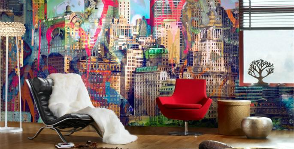
Modern photo wallpapers are not at all similar to their predecessors; today they are a fashionable interior design detail. The main advantage of photo wallpapers is that they emphasize your personal or family style.

Decorating with fabric is an ancient, sophisticated way to decorate walls. What has changed in this area with the advent of latest technologies? What are modern textile wallpaper?

The cost of a roll of wallpaper from a modest factory and from a well-promoted brand can vary tenfold. And paper can be more expensive than embossed vinyl. Why do wallpapers cost differently?

The decoration of the bathroom and toilet provides no less room for imagination than the interior of a bedroom or living room. Many materials that seemed out of place just yesterday are at the height of fashion today.

Can wallpaper from artificial material be eco-friendly? They can if the material is non-woven fabric. Durable, easy to use and very decorative.
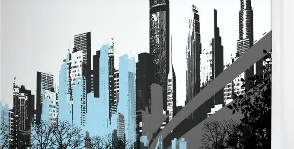
New technologies for creating patterns on wall coverings can transform space ordinary apartment. Which special effects can you count on and which are myths?

Do you want to do it urgently? redecorating? Inexpensive wallpaper is at your service. Just a few hundred rubles, a little skill and basic knowledge - and your room looks like new.

Some wallpaper can be pasted without first applying an adhesive mixture to it. It is enough to apply glue to the wall. Others need to be glued traditionally, by coating the canvas with glue. What does this depend on?
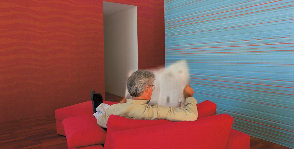
Most types of wallpaper consist of two or more layers. The top layer usually gives the name "vinyl" or "paper" wallpaper. What are the advantages and disadvantages of vinyl and paper in wallpaper?
It is not always easy to find a finishing material that suits your taste, design and color on your first visit to a hardware store. Therefore, it is advisable to take into account all the features. Now the range is very diverse. Wallpaper has always been and remains popular in wall decoration. Every year their types and options become more and more numerous. Vinyl wallpapers are in particular demand. In this article you will learn about their types and composition, pros and cons.
Composition of vinyl wallpaper
They are a two-layer material, the lower part of which can be made of non-woven fabric, vinyl or paper. The top has a thin layer of polyvinyl chloride. Knowing this will help you figure it out before purchasing. Don’t rush to buy the first wallpaper you see, as they have different characteristics:

- some of them can be easily cared for;
- others have high performance;
- they might just be beautiful.
In addition, you should pay attention to the structure and type of the top layer on the front side.
When choosing vinyl wallpaper for walls, pay attention to the fact that they can be smooth, foamed or with a hard texture. To make everything clear, let’s look at this in order.

For example, wallpaper for walls that imitate brickwork does not have a relief. They always have a smooth surface. They are the most durable. Washable vinyl wallpaper is designed for the bathroom, kitchen and hallway. They are produced using the embossing method. An expensive option for vinyl wallpaper for walls are those made using silk-screen printing technology. Looking at them, you will certainly compare them to silk.
Foam wallpaper
Wallpaper companies are constantly introducing innovations and new solutions, despite the fact that the wallpaper production process is well established. They create new types of finishing materials for walls.
![]()
The beautiful and voluminous appearance of foam wallpaper is achieved by pressing out a stencil. The layers of vinyl are treated under very high temperature. The substance begins to evaporate and this causes bubbles and pores to form on the surface, and the cavity of the material becomes airy and thick. This is what gave them the name - foamed.
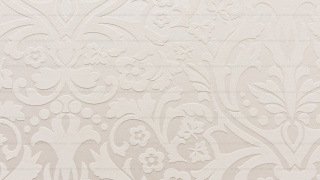
Foamed vinyl wallpaper has a textured surface. The photo shows how voluminous the texture looks. In appearance, vinyl wallpaper seems heavy, but in reality this is not the case at all. This impression is conveyed by the embossed structure. In appearance, in places where foaming occurs, the surface is always fragile, which makes them not very durable. So, this can be attributed to their disadvantage.
Firmly textured vinyl is called heavy vinyl.

It was so named because of its density and heaviness. In its production, heat treatment is used - vinyl is evaporated. This prevents harmful substances from remaining in the wallpaper structure. The appearance of this material may include imitation of stone, textiles and watercolors. When manufactured, this type of wallpaper becomes like leather.
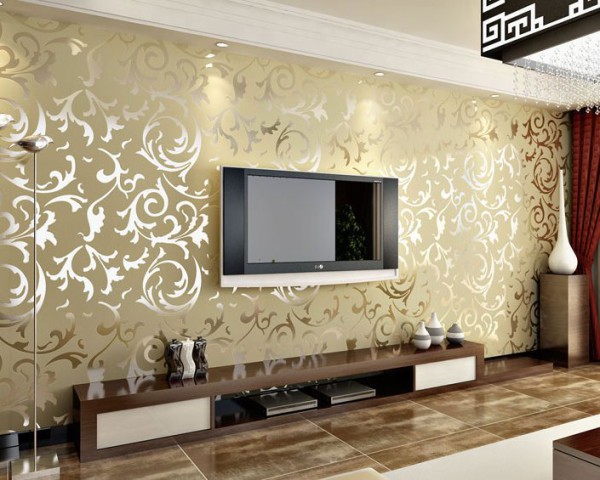
Looking at the photo of the interior of a room using vinyl wallpaper, one can note that their appearance is much more interesting, which was the beginning of the displacement of paper ones. New products include foam wallpaper. You can see from their texture in the photo how much more voluminous they look. Their base can be non-woven fabric, vinyl or paper. They have excellent decorative properties and long service life. This is their main advantage. In addition, it should be noted that the price for them is not high.
In order for the walls of offices, shops, houses or apartments to look cozy, you need to choose wallpaper that matches design solution. Then you can use not only neutral wall decoration. Example in the photo below:

Look at the photo below how bright design and splendor of form on vinyl wallpaper with a non-woven base. The glitter added to the acrylic foam shimmers very original under the rays of light. The only downside to glitter is that it can fall off the wall. In this regard, it is not advisable to use them to decorate the kitchen and hallway.
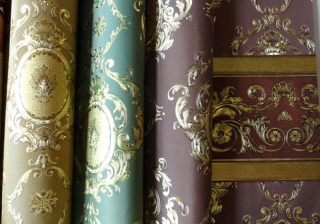
Feature of hot stamping
This name for the production technology of wall coverings is conditional. This type of vinyl wallpaper has a two-component coating.

The base is non-woven fabric and paper, and on top is a layer of foamed polyvinyl chloride. A drawing is created on the finishing layer. In order for the vinyl layer to soften, the material is placed in a well-heated chamber. When the surface becomes pliable and plastic, it is processed with two rollers. They form the finish decorative coating, as can be seen in the photo.
![]()
Types of embossing
Silkscreen printing. It has a very flat and absolutely smooth surface, in areas of which color waves are clearly visible. The canvas has the effect of silk fabric, with beautiful shimmers in the light. This is achieved not by color, but by the play of light in the drawing. The thickness of this material is the thinnest. It contains discreet drawings or patterns.

See how it looks in the photo above.
Compact - vinyl. The wallpaper is thick with a clearly visible relief structure. More often it is made in the form of brick or stone masonry, brush strokes, edged wood, etc.
![]()
The result is a dense canvas, and the embossing has a clear relief, which is clearly visible, for example, as in the photo. It can be created in the form of embroidery, natural stone, leather or fabric.
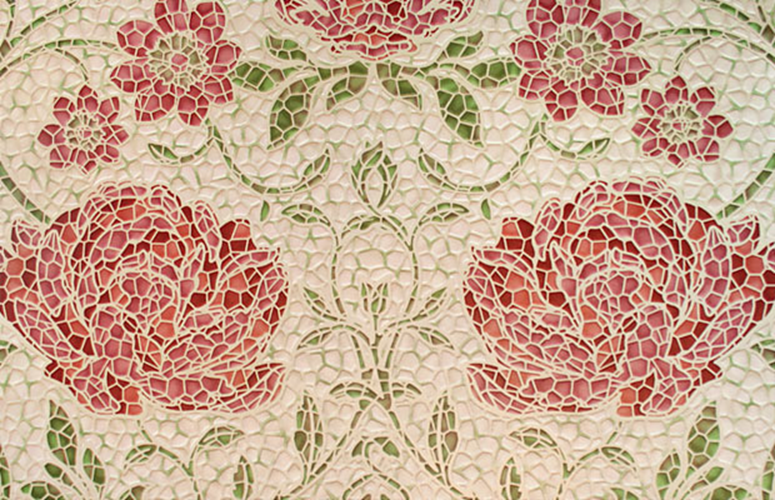
Inhibited vinyl is chemically embossed, which makes it washable. This gives the canvas excellent durability. They are not afraid of any detergents and feel great in the kitchen or bathroom.
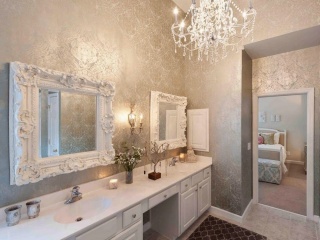
Advantages and disadvantages
The advantages include the fact that they have high strength and a variety of colors. It becomes possible to select a specific color scheme, corresponding to the interior. Create and embody your own style. With this type of wallpaper you can achieve a unique wall design in any room. Big color palette, a wide selection of patterns, designs, textures to create different styles in interiors is a huge plus. Look at the photo below.

If you decide to wallpaper your kitchen, it is better to choose a base with smooth vinyl. This allows the coating to withstand moisture and any physical impact. An undoubted advantage is its cleaning properties. Therefore, they can be easily wiped with a cloth or brush. Some types of vinyl coverings are abrasion resistant, which will also be a pleasant plus.

The advantage is that smooth vinyl does not fade in the sun, so there are no restrictions on its use. Wallpaper with a non-woven backing is very easy to stick to walls. They can be immediately applied to the wall and leveled. With the help of this material, various cracks on the wall and unevenness of plastered surfaces are perfectly hidden. They do not contain harmful substances, myths about which wander on the Internet. This canvas can be used to decorate a room in an apartment or a house. The main thing is to choose it correctly.
The disadvantages of vinyl wallpaper include their airtightness and the presence unpleasant odor new wallpaper, which disappears with proper ventilation of the room. Vinyl wallpaper tends to expand when hung, and shrink when drying on the wall. Therefore, they require careful preparation of the walls and some skill when working. This property should also be considered a disadvantage.
Important Selection Factors
The choice should be based on the purpose of the room. User reviews recommend choosing wallpaper based on the advice of consultants or reading in advance what qualities and advantages they have. In addition, you can choose yourself. It's done like this. Rewind the sample a little. When it comes from him bad smell, this suggests that wallpaper production is cheap, in which inexpensive chemical substances containing harmful additives. Sellers will deny this, citing various arguments that the smell comes from a new product, etc.
To create comfort in living rooms, it is necessary to provide them with good ventilation. Not all types of this material are breathable. Therefore, for such rooms you need to buy wallpaper made of hard vinyl. There will be no allergies from them, due to the absence of active chemicals in their composition.
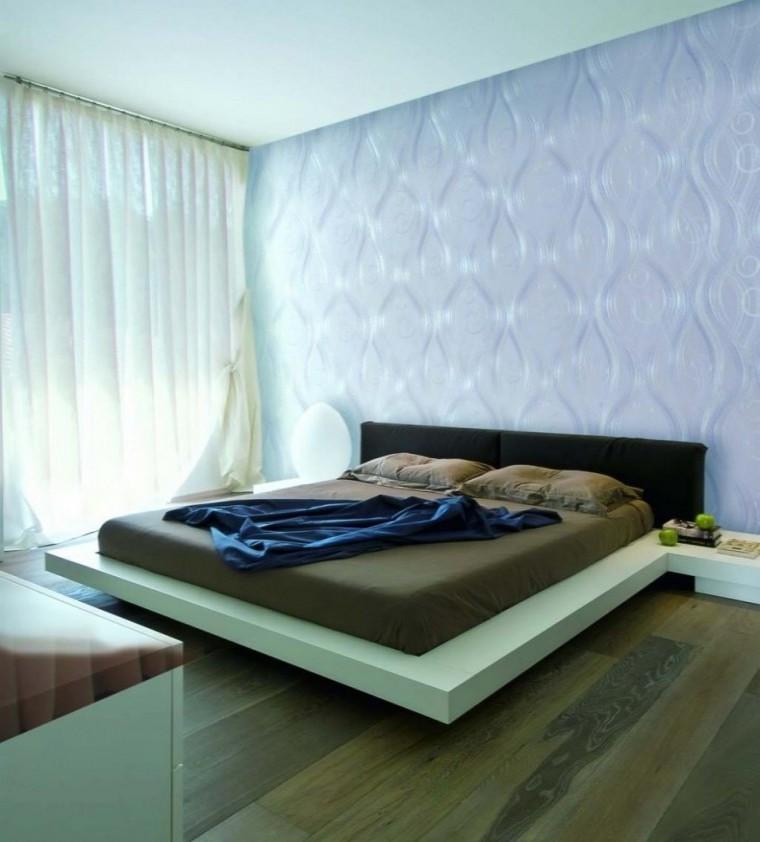
If you need to choose vinyl wallpaper for the bathroom or kitchen, make sure that it is water-repellent, water-resistant, wear-resistant and impact-resistant. They can be washed with a brush.

Pay attention to the markings. To determine practicality, look at how many waves are shown on the packaging:
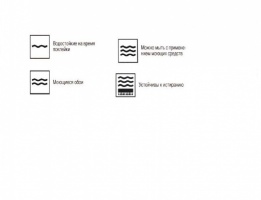
- 1 wave - water resistance;
- 2 waves - washable with water;
- 3 waves - washable with the use of products;
- 4 - marking indicates that they are washable and resistant to damage.
You can buy high-strength vinyl wallpaper in specialized stores. They are presented in a large assortment. For their gluing it is important right choice glue. It must withstand moisture and ambient temperature well. If you bought heavy wallpaper, be sure to first read the manufacturer’s instructions for hanging this wallpaper. There will also be information on the recommended glue.
When choosing the appropriate option, look at the catalog of various vinyl wallpaper options. Find out the recommendations of experts to properly design your living space. Only after you accept the most correct solution, you can buy wallpaper and start gluing it. You can do this yourself without resorting to the help of specialists.
The following video will help you when choosing vinyl wallpaper:
Doesn't lose its popularity. However, over time, their production technologies change. Today, the construction market offers vinyl wallpapers with a wide variety of specific features. When making a decision, it is important to familiarize yourself with the features of their production and the materials from which they are made. Like all wallpapers, vinyl has strengths and weaknesses. This needs to be taken into account when choosing this.
Vinyl wallpaper: what is it?
Modern technologies have significantly influenced the production of vinyl wallpaper of various types. Wallpaper contains a variety of materials that influence its characteristics.
The material used to make wallpaper is vinyl. Its chemical name is polyvinyl chloride. This is a common type of plastic that is widely used in the chemical industry.
Polyvinyl chloride is used for a variety of purposes, which indicates the versatility of this material.
Areas of application of the material in industry:
- Electrical;
- Lightweight;
- Food;
- Mechanical engineering;
- Shipbuilding;
- Agriculture;
- Medicine;
- Construction.
Due to its characteristics, vinyl is widely used in construction industry. Vinyl wallpaper is a wall covering that includes two layers: a paper or non-woven base and foamed or simple polyvinyl chloride.
Vinyl wallpaper: composition and characteristics
The composition of vinyl wallpaper may vary. It depends on its characteristics and scope of application.

Composition of vinyl wallpaper:
- Paper. The known material is derived from cellulose, which is obtained from plants and recycled materials.
- Textile. Produced in weaving factories. The fabric is made from threads that are flexible and smooth. It can be linen, cotton, silk, wool.
- Non-woven fabric. The material is made from cellulose fibers. They can be glued, unglued, modified or not. Non-woven fabric is highly durable.
- Fiberglass. The material is made from durable fibers, which are thin glass threads.
Depending on the material, wallpapers are divided into corresponding types and have different characteristics.
Characteristics of wallpaper types depending on the material:
- . They are made from different types of paper. Wallpaper consists of two layers: a base and a top decorated layer.
- . The wallpaper is based on non-woven fabric or paper. The top layer is made of fabric various types: silk, linen, cotton, jacquard.
- . The wallpaper is based on non-woven fabric. The top layer is made of.
- Glass wallpaper. They are a mixture of glass fibers that provide fire resistance to the material.
Depending on the materials used, vinyl wallpaper has a wide variety of characteristics.
Vinyl wallpaper is strong, reliable and durable. Thanks to the top vinyl layer, they are easy to clean and resist chemical and mechanical influences.
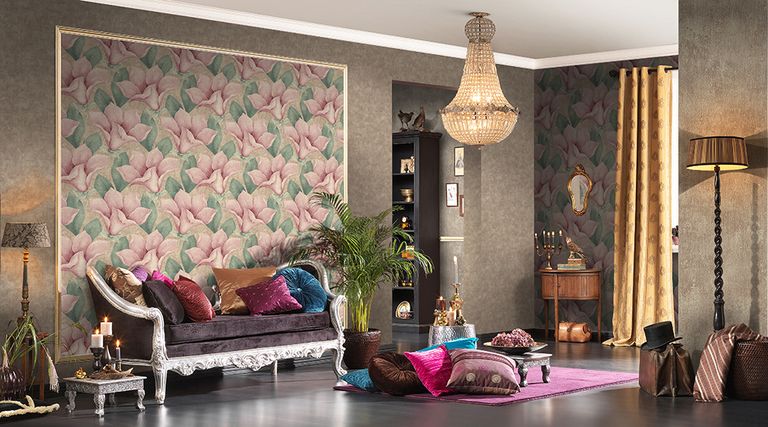
Vinyl wallpaper has become widespread due to its universal qualities. They are used for pasting various types of premises.
Types of vinyl wallpaper: 4 main coatings
The appearance of vinyl wallpaper is determined by the top layer, which has different manufacturing technologies. It can be a flat surface or raised plates.
The thickness of the wallpaper, its density and weight, air permeability, appearance how long will they last?
The most widespread are four main types of wallpaper, each of which has characteristic features.
Foamed Vinyl
It has a clear relief and porous structure. It is this that allows the material to allow air to pass through. This type of wallpaper is easy to work with. Wallpaper can be used on uneven and unprepared surfaces, since its foam structure can hide defects. Wallpaper is easy to clean, dries quickly, and is relatively light in weight.
Smooth Vinyl
It has a second name - thick vinyl. The material has a dense structure. Has a smooth surface. Sometimes they may have a relief in the form of bricks or stones. The material is easy to care for using detergents. It is usually used for pasting rooms with high levels of humidity.

Hard vinyl or compact vinyl
This type of material has a dense structure. He usually imitates different types surfaces: fabric, tiles, plaster. Due to its durable structure, the material is resistant to mechanical and chemical damage. At the same time, they have sufficient breathability.
Silkscreen printing
This type of material resembles silk, which is why it got its name. For its production, hot stamping technology is used.
The type of wallpaper should be chosen depending on the type of room, its purpose and interior features.
